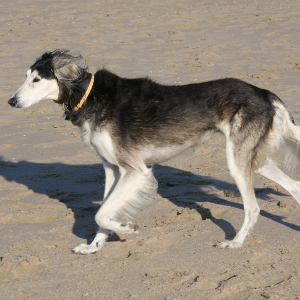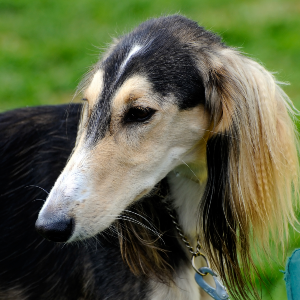
Saluki
The beautiful and exotic Saluki has an adoring fan base and mysterious beginnings. Though they may not be the best fit for every household, Salukis can be loving and warm companion pets with the proper training.
Interested in discovering if your dog is a Saluki?
Check out Wisdom Panel's DNA tests.

Saluki Traits
General Appearance
This sleek breed exudes speed. Salukis' smooth, silky coats have slight feathering on the legs and backs of the thighs. Their silky, hair-covered long ears hang close to the head. And dark hazel eyes suggest the breed is always ready for adventure.
Coat and Coloring
The Saluki's coat may be feathered or smooth. The main difference is that the smooth variety has no feathering. This breed comes in cream, white, golden, fawn, red, grizzle and tan, tricolor (tan, black, and white), or tan and black.
Distinctive Physical Traits
The Saluki is a graceful and agile breed with a streamlined body and smooth, silky hair.
Saluki Temperament
The Saluki is a pack animal breed that desires attention and struggles when left alone for long periods. These dogs are gentle and loving. But they require socialization and training because they're also independent and strong-willed. You should always supervise your Saluki when they're around small kids.
An active breed, the Saluki requires plenty of space to run and exercise. But because of their strong instinct to hunt, Salukis should never be allowed off-leash when outside unless they are in a very secure area.


Saluki History
One of the oldest dog breeds, the Saluki may date back to 7000 B.C. But beyond that, we don't know much about the breed's origins.
We do know, however, that noblemen and kings throughout history favored the breed. In fact, experts think Egyptian pharaohs and Alexander the Great were Saluki owners.
In England, organized breeding began in 1895. And within three decades, the Saluki gained its brand standard—as well as recognition from the Kennel Club of England. Today, these sleek, beautiful dogs continue to draw people.
Saluki Care
Nutrition
Salukis thrive on an age-appropriate, high-quality diet. It's important to monitor how much your Saluki eats since some dogs are prone to gaining excess weight as they age. If this happens to your pup, consider cutting back on portions (or treats). Appetites vary among Salukis. So, check with your veterinarian if you're worried about how much your dog is eating.
Grooming
Whether feathered or smooth, the Saluki coat is easy to groom. A weekly brushing should keep it looking healthy and shiny. Feathering along the ears or tail might require more frequent care to prevent matting and remove dirt. A device called a "snood" may also help keep ear feathering away from food bowls.
Trimming nails, cleaning ears, and brushing teeth should also be part of every dog's grooming routine, regardless of breed.
Exercise
The Saluki is an energetic, active breed that requires daily exercise to stay healthy. These dogs are happy to run in a fenced yard or go for long walks or runs with their people. They also excel in canine sports—such as agility and lure coursing.
Without enough exercise, Salukis may become bored—which could result in destructive behaviors or attempts to escape.
Training
With independent, stubborn tendencies, Salukis need early socialization and obedience training. Crate training may also be necessary, as this breed may get mischievous when left alone.

Saluki Genetic Health Conditions
-
Neuronal Ceroid Lipofuscinosis 8 (Discovered in the Saluki)
Neuronal Ceroid Lipofuscinosis 8 (NCL8) is a progressive neurologic disease characterized by uncoordinated movements, behavioral changes, vision loss, and seizures.
-
Succinic Semialdehyde Dehydrogenase Deficiency (Discovered in the Saluki)
Succinic Semialdehyde Dehydrogenase Deficiency (SSADHD) is a neurologic disorder characterized by seizures, uncoordinated movements, and abnormal behaviors, such as vocalization episodes. The associated genetic variant has been identified in the Saluki.
Knowing if your Saluki is a carrier or at-risk for these conditions can help you and your veterinarian plan for your pup’s lifelong care. With Wisdom Panel™ Premium, you can get results for over 200 genetic health tests.
Breed Group
Middle Eastern and African
While this ancient group shares many of the characteristics of the Hound Group, their origins, as the name would suggest, are concentrated in Africa and the Middle East unlike the hound group that has no true geographic center.
Resources
https://www.akc.org/dog-breeds/saluki/
http://images.akc.org/pdf/breeds/standards/Saluki.pdf
Reviewed July 26, 2020 by Laura Inman, DVM































